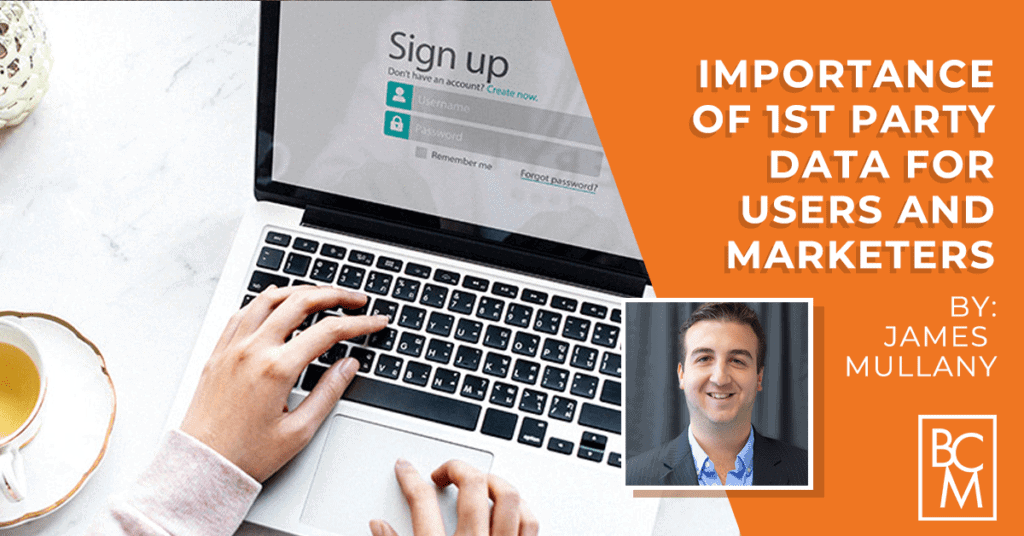
First Party Data: The Ultimate Guide for Marketing & Advertising
Your company is at risk of losing customers and sales to the competition.
That is, if you don’t find a way to collect first party data and profile potential customers.
Google recently extended its schedule to kill the 3rd party cookie to late 2023. However, the pressure for a solution is still highly urgent. New cookie and data collection regulations will take effect, which means marketers’ ability to collect and analyze customer information is going to change – big time!
Many organizations have already begun the transition to a cookieless future by utilizing first party data. This type of data is known to be more beneficial and cost-effective than third party data to build relationships and create more targeted advertising.
With headlines from The Economist saying, “The world’s most valuable resource is no longer oil, but data.” And with more than 230 million digital shoppers in the United States, it’s time for companies to understand what first party data is, how it can be used to increase sales, and how a partner like Salesforce can help collect and manage first party data.
In this article, you’ll learn:
- What is First-Party Data?
- First Party Data vs Second Party Data vs Third Party Data: What’s the Difference?
- Benefits of Collecting First Party Data
- How to Collect First-Party Data
- Common Challenges of Collecting First Party Data
- Implementing First-Party Data with Salesforce
- How to Use First Party Data in Advertising
Let’s get started!
What is First Party Data?
First party data is the information that companies collect directly from their customers. Advertisers are now moving to a first-part data strategy as stronger data collection regulations and platform intermediaries, such as Apple, place an emphasis on customer privacy. Companies will need to own their customer data directly, so they can make their brand relevant and truly resonate in the new privacy first environment.
Examples of first party data:
- Ecommerce Purchase history
- Time spent on your website
- Demographics of your customers
- Tracked activity on site pages
- CRM data
- Subscription data
- Social data
- Customer surveys
- Customer feedback
- Email interactions

First Party Data vs Second Party Data vs Third Party Data: What’s the Difference?
Today, more than ever, where you obtain your data matters. That’s why it’s essential to understand the major differences between first party, second party, and third party data. Knowing the differences will help you develop the right data strategy to build relationships, keep customers, and create more effective advertising.
What is Second Party Data?
Second party data is a relatively new concept, and it’s comparable to first party data, except it comes from another source’s first party data. Another company obtains data directly from their customers and sells it directly to other companies.
Many organizations trust second party data because of its high-quality, accuracy, and known source (your second party data partner). Second party data helps scale first party data by allowing you to reach a broader, and possibly newer, audience.
Second party data also helps assess potential future behaviors and patterns of customers. This type of data is beneficial because you can see how another company’s audience interacts with other sites. This insight helps you more efficiently target your advertising.
In order to obtain second party data, you must find a partner that directly collects first party data and buy it from them. This process is often long and complicated, depending on your industry and the sophistication of the counterparty. Please read this case study on how Beeby Clark+Meyler helped to massively scale a retargeting program through second party data. (ERA and Zillow case study link).
What is Third Party Data?
Third party data is more commonly known in the world of advertising because it’s the data that is most easily and readily available. Third-party data is the information companies purchase from large data aggregators. This data is pulled from various outside sources, websites, platforms and other data brokers.
Aggregators purchase data from publishers and other data owners, collect it into one massive set, and sell it as third party data. Often, aggregators will separate the sets into categories such as audience behaviors, demographics, and industry. However, it’s important to remember that data providers sell third party data fast and in large volumes. This lack of exclusivity means you don’t know how reliable the data is for your specific needs and your competitors have access to the same data.
When combined, first party data and third party data can potentially help enhance customer acquisition, expand your audience, and increase the precision of your targeting. However, due to privacy regulations and the policies of technology companies such as Apple and Google, the quality of third party data is becoming increasingly unreliable.
5 Benefits of Collecting First Party Data
First party data is essential if you want to reliably reach and convert high quality prospects. Reliable reach and well crafted creative enable highly relevant advertising that your prospects will recognize as meaningful to them.
Your customers want every interaction they have with your brand, inclusive of your advertising outreach, to be a relevant experience. First party data allows you to do that – and so much more!
1. Compliance
You collect first party data with direct consent from your audience (meaning they opt-in to contact), and the information collected follows data privacy regulations like the GDPR and CCPA. Consumers and Regulators are now viewing third party data collection as violating users’ privacy — which is a big reason Apple and Google are disabling its use. There are also substantial fines for this.
2. Relevance
First party data comes directly from the source. This provides a chance to better personalize your buyer’s journey and give them the experience they desire, from initial advertising contact, to purchase, through to renewal or up-sell/cross-sell. As the first party data set builds, your ability for even more effective targeting will increase.
The most significant benefit comes from look-alike modeling, which allows an advertiser to build proprietary audience segments based on high-quality data from their audience. Look-alike models permit both efficient media delivery and more relevant messaging. This is critical when advertising in competitive categories within a media environment that has become fairly consolidated.
If everyone is advertising on Google, Facebook, and Amazon, how will you differentiate yourself? The answer is simple: Through insights gleaned from your first party data.
3. Cost Efficiency
Most companies are known for purchasing third party data because it’s easy to acquire and readily available. However, depending on the platform and/or source, purchasing data can be costly. Not because the third party data itself is costly. In fact, much third party data is extremely cheap. But, in advertising as in the rest of life, you get what you pay for. Once ad delivery is considered (the percentage of media that actually reaches the intended target), third party data can be expensive indeed.
First party data is collected by you — which is basically free for companies — outside of the cost of time and effort to collect the data. It is also much higher quality, delivering higher returns.
4. Data Accuracy
Since first party data is collected straight from the customer, it’s extremely accurate. There is no third party tampering or interpreting the data. It’s simply you and the customer.
5. Builds Customer Relationships (LTV)
First party data gives you the ability to provide value as soon as the customer provides information. This is a key element for companies under pressure to retain and grow customer lifetime value.
With first party data, you can take advantage of marketing automation systems such as Salesforce Marketing Cloud’s Journey Builder. Journey Builder provides an efficient tool for mapping and personalizing content delivery at every stage of your customers’ relationship or stage in their life-cycle. It also helps you upsell, cross-sell, and automate Lapsed Customer or Win-back programs across email and social media fairly efficiently.
How to Collect First Party Data
For years, companies have relied on third party data to avoid asking users to register with their websites. As we’ve mentioned, companies will no longer be able to use third party data without consequences. Businesses will now have to get more creative when collecting customer data.
The ever-changing online world has taught us that users are willing to provide their information as long as they get value in return. For example, your website visitor will gladly give you an email address for a more personalized experience or a free piece of premium content.
What users don’t want is to give you their information, and then you still don’t provide a more personalized experience or just bombard them with low-value emails. This will lead them to feel betrayed, forcing them to look to competitors for future purchases.
There are many ways you can collect first party data, such as:
- Website Profile centers
- Social media
- Purchase confirmation
- Calls-to-action
- Initial User registration
- Premium content (whitepapers, eBooks, etc.)
View first party data collection should as an ongoing process. We see very low conversions when seeking to collect more than 2-3 data points about a prospect or customer at initial engagement. Start simple by collecting names and email addresses. Later, invite customers to submit further information in exchange for clearly stated benefits and added value.
Common Challenges of Collecting First Party Data
In Advertiser Perceptions’ latest study, US digital marketers revealed that they were using only 47% of the first party data their company collected.

Although first party data is a reliable source of information, it can be difficult to collect and manage. Here are a few of the most common challenges companies face when collecting first party data.
Integrating Data Platforms
Companies collect data in many different ways. The challenge of collecting data in different ways is putting all of the data together in a useful form for communications.
Data is much easier analyzed when there’s a single source of truth. Integrating data platforms can be a little overwhelming, but when done correctly, it pays off tenfold. Luckily, platforms and services are available today, again like Salesforce or Adobe, that can make it easier to integrate your data into a single place via ready-made APIs.
The winners are mapping their data collection points to their CRM or CDPs (Customer Data Platforms) and using customer engagement as an opportunity to more completely fill in customer profiles. The laggards are standing pat with separate siloed systems and continuing to rely on the third party data crutch.
Lack of Data Strategy
As a marketer, you know how important it is to strategize. Unfortunately, lack of planning is one of the main reasons companies have a hard time collecting and utilizing their first party data.
They may have a strategy to collect data but don’t have an action plan once they actually obtain it. Companies need to know what data they’re seeking out and how they’re going to put that data into action in advance.
Clearly defining your goals, collection methods, sources of information, and outreach methods ahead of time will increase the quality of data collected and the results obtained. In addition, the more in-depth your data strategy is, the easier collecting and analyzing data will be.
A very simple, top-line data strategy is better than no strategy. One simple way to begin is to start with customer stages and identify:
- Prospect or customer objective at that stage
- The action required to achieve the objective
- The data needed to execute the action
The illustration below is a simple top-line example of mapping data needs to help Prospects of an education services company convert to Orientation Takers, a critical step in the overall conversion journey for this client. Delivering testimonials, incentives, and reminders to prospects leads to higher conversion of a Prospect to an actual Orientation attendee. This is an example of starting simple, then scaling to the more complex.

Combining 1st Party Data with 3rd Party Data
We briefly touched on the power of combining first party data and third party data, but let’s dig a little deeper. When you take your organization’s personal, raw data and overlay it with demographic, behavioral, and attitudinal insights, you can tap into a massive amount of targeting and messaging opportunities.
This process may appear more overwhelming for many marketers than it actually is. Many agencies routinely perform this operation for clients. But historically, clients have mostly used their own Data Management Platforms (DMPs) and, more recently, Customer Data Platforms (CDPs) to accomplish this task.
At BCM, we recommend that clients own this process and take control over the audience segmentation process. Audience data will become your most important asset.
Implementing First Party Data with Salesforce
By now, you know what first party data is and its benefits, plus the differences between first party, second party, and third party data. So, where and how do you begin implementing first party data?
You begin with email collection through your website and social media sites. Also, consider installing Facebook audience pixels on your website. After these initial steps, you should consider partnering with a reliable vendor like Salesforce who offers various solutions and pricing tiers to solicit, collect, classify, distribute, and manage data.
Having a Customer Relationship Management (CRM) tool like Salesforce is essential for today’s data-powered marketer. CRMs help you organize who’s actually buying your products and using your services, who your loyal customers are, and how they moved through their journey to make a purchase or decision. It’s also the database where all of your leads live.
Once you have a CRM system in place, you can graduate using marketing automation by deploying Marketing Cloud. More advanced organizations have retired their DMP’s and are investing in more flexible Customer Data Platforms (CDPs) to help turn data into actionable business results. In other words, you can have all of the data collected on customers in one place and organize the kind of content to release and when to release it.
Moving away from third party cookies is highly uncomfortable for advertisers and the digital advertising industry. However, you must make this move before it’s made for you by either Google or government regulators.
The CRM and marketing automation platforms in existence today do help solve many of the data connectivity and compliance challenges that marketers dread. These platforms also allow for starting small and scaling through components that can be added as capabilities are built.
Our agency, BCM, routinely provides guidance on client-side marketing technology stacks with an emphasis on matching investment levels with client readiness.
How to Use First Party Data in Advertising
Using tools like Salesforce and Google Analytics makes using first party data easier for businesses to connect with people who have existing relationships with their organization. They also help build relationships with those who may be interested in their brand.
Whether using first party data for retargeting customers or sending a customized message, there are several ways for marketers to use this convenient data in advertising. Here are the top three ways:
Targeting With First Party Data
First party data is unfiltered, high-quality data that is unique to your organization. You can use this data to significantly improve the targeting and retargeting of your advertisements. Two methods to improve your overall ad targeting using first party data are:
- Look-alike Modeling: By overlaying demographic, behavioral, and attitudinal data over your customer data, an advertiser can build rich profiles of their best customers and then target prospects that fit within that profile.
- Lead Scoring: As prospects hit your website and begin to engage with your business, you want to quantify what makes a lead valuable. Your first party data, particularly the profile attributes of your most valuable customers, provides the criteria to assign a value to leads. As your media campaigns draw leads to your website, you can evaluate your campaigns based on their ability to attract high-value leads and optimize your targeting accordingly.
Personalization
First party data allows you to see a user’s interests and desires. Therefore, you can find ways to personalize their journey based on the insights.
For example, suppose you’ve looked at your first party data and notice that a certain customer is a repeat visitor to your site. They have downloaded premium content, signed up for emails, browsed various products or services. You now know that they’re on the verge of deciding whether to work with your business. This is the time to send them a personalized email with more in-depth content or maybe even a testimonial video about a product they’re considering. Send something that’ll give them the push they need to decide while appealing to their wants and needs.
Consumers not only want a personalized experience when shopping — they expect it. In a Harris for Redpoint Global survey, 63% of consumers said they expect personalization as a standard service. With a more personalized experience, more users will stay on your site and purchase from your store rather than competitors.

Enhance Conversion Rate Optimization
First party data drives customers to take action. For example, if your favorite color is blue and advertisers target you with yellow clothes, you’re much less likely to buy than when you’re sent ads for blue clothes.
According to a BCG survey, marketers using first party data generate double the revenue from a single ad or placement. What first party data provides is a better shot at achieving relevance in your advertising. This relevance drives conversion through higher quality targeting at the top of the funnel to more personalized follow-up as engagement deepens.
Conversion rate optimization is a combination of the in-store or on website experience and offsite engagement and communication. First party data helps these two critical components work in tandem to create better outcomes.
Thank you for reading this article on first party data. Please do not hesitate to contact us if you would like a quick consult on first party data strategy.



